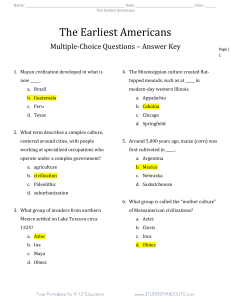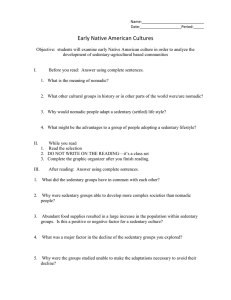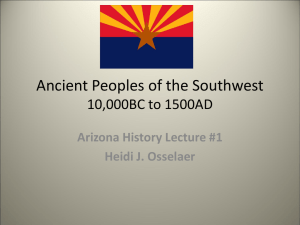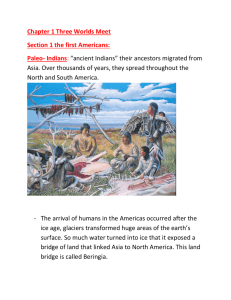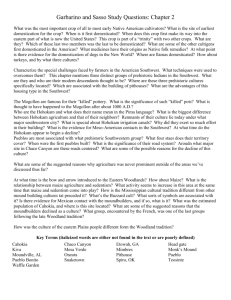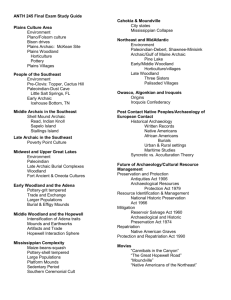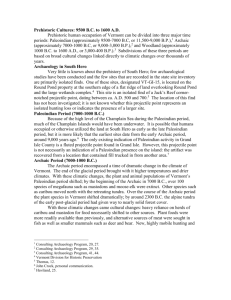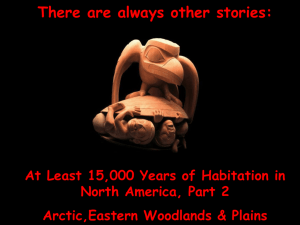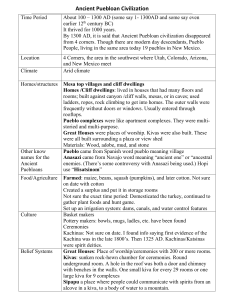PowerPoint to accompany this lecture
advertisement
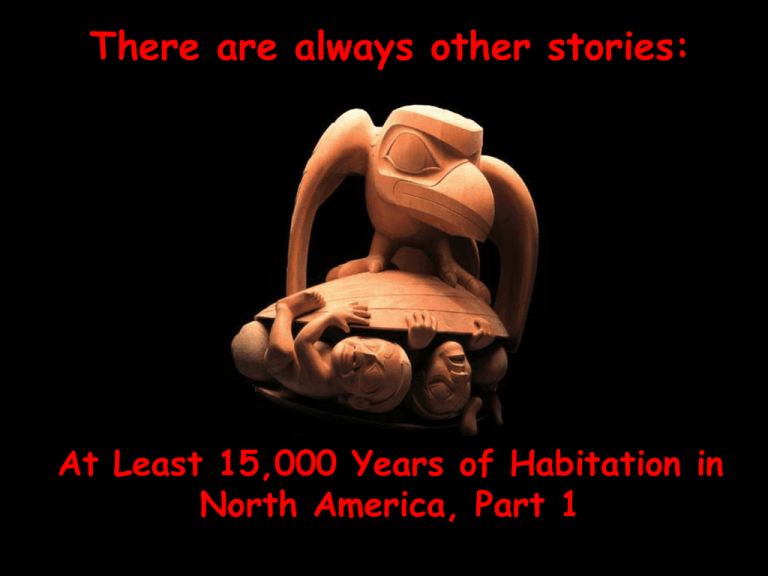
There are always other stories: At Least 15,000 Years of Habitation in North America, Part 1 Today’s archaeologists understand that human migration to the Americas occurred by many different means and over a vast period of time. Meadowcroft Rockshelter, Pennsylvania, 19,000 B.P.? Some radiocarbon (C14) dates are even older. Monte Verde, Chile, 30,000 B.P.? Very much older… Pedra Furada in Brazil is extremely controversial and has dates and rock art as much as 50,000 years B.P. Most of the early dates are extremely controversial, and should be. Why? Extraordinary claims demand extraordinary proof! So what do we really know with reasonable certainty? That the ancestors of contemporary Indians were here by at least 12,000 years ago. Even that used to be controversial… Left: first Folsom point, found with extinct bison rib Aleš Hrdlička …until the Folsom, New Mexico find in 1926-27. Folsom points According to the archaeological stories, how did the first people get here? The migrations began during the last glaciation, that is, the Wisconsin advance of the Pleistocene epoch, some 100,000 years ago. Massive ice sheets as much as 1.5 kilometers thick covered much of the northern hemisphere. There were profound changes in climate including compression of the earth’s climate zones toward the equator. With so much of the earth’s water locked up in the glaciers, sea levels dropped nearly 100 meters. Lowered sea levels exposed vast areas of the continental self, including Beringia, an unglaciated “land bridge” nearly 1500 miles wide. One route allowed early hunters to pass through an ice-free corridor from Siberia into the rest of the North American continent. There may have been as many as three “waves” of people starting about 15-16,000 years ago. The migrations were slow, with people following herds of game, the Pleistocene “megafauna” such as mammoth, most now extinct. They probably didn’t know they were entering a new land. We know now that they also followed the coastlines in boats, which have been used by modern humans for 40,000 years. Evidence that some people used boats has recently been found on several of the islands off the NW coast and Alaska. The PaleoIndian Tradition: Was Clovis first? By 12,000 years ago, Clovis peoples were hunting mammoth and other megafauna. The hunting weapons of choice were the speathrower (atlatl) and dart or spear. Rock art images of atlatls are common As populations grew and people settled into their environments, the range of projectile points expanded. Clovis, Folsom and Plano points While the earlier Clovis peoples hunted mammoth, Folsom and Plano cultures were extraordinary bison hunters from around 10,000 years ago until around 8,000 years ago. Pleistocene Extinctions? Did PaleoIndian overkill contribute to the demise of the megafauna? More realistically it probably was a combination of: •Hunting pressure •Climatic change •Diseases •Shifting breeding seasons As the glaciers melted… …the seas approached contemporary levels, closing off the land route to North America. For all we now know, we still have lots of questions, and recent discoveries still have us asking… Major controversy began in 1996 with the discovery of the ‘Ancient One,’ Kennewick Man. Kennewick Man, or the Ancient One, as the Umatilla nation of Washington calls him Unfortunately James Chatters’s descriptions of him as “Caucasoid” got confused with “Caucasian.” Is repatriating such remains a ‘crime against science’? Is not repatriating them an echo of the 1890s Moundbuilder myth? Spirit Cave Man Found: 1940, in Spirit Cave near Fallon, Nev. Age: 9,400 years His mummified remains are very similar to Kennewick in physical features Luzia Found: 1975, in Lapa Vermelha, Brazil Age: 11,500 years Luzia died in her early 20s. Although flint tools were found nearby, hers are the only human remains in Vermelha Cave. The anatomy of her skull and teeth - including a narrow, oval cranium, projecting face and pronounced chin likens Luzia to Africans and Australasians. Brazilian anthropologists propose that Luzia traveled across the Bering Strait, perhaps following the coastline by boat, from northeast Asia, where her ancestors had lived for tens of thousands of years since exiting Africa. A direct European connection? Archaeologists Dennis Stanford and Bruce Bradley have suggested that there might be a link between Clovis and the Solutrean culture in Europe. Archaeologists have suggested many possible routes for the early inhabitants of the Americas. The controversy has lead to a wide range of books… Even novels... So who are these anomalies and why did they disappear? They could be statistical anomalies, and just extremes in a highly diverse Indian population. They may have been different, but here in such small numbers that they didn’t affect the gene pool— traders, explorers, wandering hunters. They were here in sufficient numbers, but died out before becoming part of the gene pool. Adaptation to varied local environments caused lots of cultural variation Regional examples of cultural periods East of the Rockies •Mississippian tradition (900 - 1550 A.D.) •Woodland tradition(1000 B.C. - 900 A.D.) •Archaic tradition (8000 - 1000 B.C.) •Paleoindian tradition(9500 - 8000 B.C.) Southwest Region Extreme regional variation 1100-1500 AD •Pueblo, 700 -1100 AD •Basketmaker 500 BC-700 AD •Archaic tradition 8,000 - 1,800 BP •Paleoindian tradition 11,500 - 8,000 BP By 8,000 years ago, the Archaic tradition replaces the PaleoIndian •A more settled life •Larger populations •Wider variety of tools •A broad subsistence base in hunting and gathering Archaic cultures were extremely stable, and in some areas of North America lasted until after European Contact. High Arctic Stability: A Perpetual Archaic Primarily seal, walrus, and whale hunters elaborate and beautiful harpoon heads, carved pendants and toys of stone, bone, ivory, and antler. Winter houses were small (10 x 8 feet or so) oval or subrectangular sod huts excavated partly into the ground and built of whale bone. Populations in winter house up to about 50 Dog sleds and kayaks were the main transportation. See the Arctic Archaeology in North America Web Site for extraordinary materials on environment, artifacts, and excavations. Bowhead whale skull over the entrance of a Thule winter house Thule culture, 1000-1600 AD Dorset Culture of the Eastern Arctic (c. 550 BC-AD 1100) Dorset is famous for its elaborate and highly evolved artistic tradition that includes carved wood, bone, and ivory depictions of humans, spirit monsters, and animals; objects are of a magico-religious nature Inuvialuit culture The Thule tradition didn't so much end as become transformed. Around 500 years ago, the climate chilled throughout the northwest Iniut peoples abandoned the islands of the High Arctic Moved to inland waterways and developed inland living strategies such as fishing with nets and communal hunting. The people maintained this new lifestyle until the Europeans invaded at the beginning of the last century Eastern North America Archaic peoples used a wide variety of tools Sandals, Texas Clay cooking balls, Louisiana Hunting Tools Used by Maritime Archaic Indians in Newfoundland Fabric from Windover, Florida, 8,000 BP Ground and pecked stone objects were widespread Ground stone ax, South Dakota A steatite vessel recovered from the Flint River Creek Site, Alabama Gorgets Net weight Atlatl weights, Illinois Metal Working of the Old Copper Culture, 3000 BP - 5000 BP Poverty Point Earthworks, 3,800 BP 6 concentric artificial earth embankments. They are separated by ditches, or swales, where dirt was removed to build the ridges. The ends of the outermost ridge are 1,204 meters apart (nearly 3/4 of a mile). The ends of the interior embankment are 594 meters apart See the major web site on Poverty Point, including videos. Foraging provided subsistence that was diverse and stable Shell Midden in CA, with artifacts from a similar midden in Canada Woodland Tradition: 2500 BP- 1000 BP Archaic with pottery and burial mounds? But oh so much more! Environmental Riches Near the Scoville site on the lower Illinois (late Hopewellian from 450 AD) •Four ecozones within a half hour's walk from site-1.8 mile radius, about 10 square miles would produce each year: •182k-426k bushels of acorns, •100- 840 deer, •10k-20k squirrels, •200 turkeys with •6 million mallards in whole Illinois River valley •Other materials not measured but vast At Scoville, 92% of meat was from deer, 4% from turkey; 72% of nuts were hickory and walnuts 27%. Site was not occupied from spring to mid-spring and mid-late autumn, coinciding with waterfowl migration, indicating they left site to harvest them Dietary Protein at Scoville •92% of meat was from deer •4% from turkey; •72% of nuts were hickory •27% were walnuts Site was not occupied from spring to mid-spring and mid-late autumn, coinciding with waterfowl migration, indicating they left site to harvest them Effigy Mounds, 2,500 years BP to 400 years BP Effigy Mounds were usually not burial mounds, but clan territory markers. Burial Mounds, Social Structure, & Belief Systems Exotic Materials in the Burial Mounds •Mica sheets cutout into geometric or zoomorphic forms •Copper used for ear spools, headdresses, masks, bracelets, beads, chest ornaments celts, panpipes •Busycon (giant sea snail) shells from the Gulf Coast used for cups with central whorl cut into beads •Freshwater pearls used as beads for anklets or armlets or sewn onto garments •Figurines carved from stone or modeled from clay were very realistic •Special class of mortuary pottery-deep bowls with expanding or globular base •Platform pipes with realistic effigies of birds, animals and people •Huge ceremonial bifaces of obsidian imported from Yellowstone National Park •Bear teeth strung as beads or pendants, as were cut wolf or bear jaws •Alligator teeth and skulls, baracuda jaws and shark teeth 22 different types of exotic materials, 16 of them minerals, only two or three local to Midwest All objects tended to be smeared with red ocher Bear teeth, real & copper Pottery was a major technological advance. Adena and Hopewell Produced a Wide Range of Exotic Artifacts Sheet mica carvings Turtle shell bowl, Illinois Effigy Platform Pipes Engraved plaque The Hopewell Interaction Sphere Trade Network The expanded use of cultivars Marsh elder/iva/ sumpweed Maize (late) Origin of cultigens Human impact on iva seed growth Mississippian Splendor 1200 BP- 500 BP The Three Sisters Provided Life… …and vast surpluses Cahokia: America’s First Urban Center Perhaps 30,000 people at 800 BP, larger than any European city of the times Monks Mound was the core of a large ceremonial complex The contents of Mound 72 Moundville, Alabama Spiro Mounds, Oklahoma Mississippian Artifacts from the Mississippi River Valley The Great Plains In many ways, an extension of the Eastern Woodlands In others, the Plains have many unique features primarily aimed at adjustments to the environmental extremes. After the Paleo-Indian adaptations of Clovis, Folsom and Plano, the Archaic continues in many areas until European Contact. Some cultures take on Woodland and maintain them until Contact while others take on Mississippian characteristics. A region of major population movements and interactions. At the core of Plains cultures? Bison Click on the HeadSmashed-In logo for virtual tours Subsistence staple and ritual focus Horticulture after about AD 800 formed the Core of Subsistence for Plains Villagers The Plains Earthlodge Village An extraordinary adaptation to Plains climate Shapes change from square and rectangular to fully round through time. Village populations ranged from a few hundred to more than a thousand. Plains Village Life Tribes at the time of Contact Distribution at time of Contact reflects population movements and the relative fluidity of Native American cultures. Cheyenne example The Southwest Desert Archaic, 8,500 BP – 1,500? BP “The Great Drought”—hotter, dryer climate at the end of Pleistocene Shift to generalized foraging of desert resources Late Desert Archaic and the Origins of Agriculture By Middle Archaic, a shift toward more settled village life A tripling of population Tehuacan Valley, Mexico—the El Reigo (The Irrigation) people developed domesticated corn as well as squash, chili peppers and amaranth some 7000 years ago. Rock Art—Evidence of Shamanic Practice? Hohokam Centered on middle Gila River and lower Salt River drainage areas A Mesoamerican periphery? Hohokam culture can be divided into several phases, a division which has found considerable favor in recent years. The fluid nature of Hohokam culture makes it difficult to pinpoint exact dates, but clearly there were distinguishable differences between these phases. Colonial Phase AD 500 to 900 Sedentary Phase AD 900 to 1200 Classic Phase AD 1200 to 1450 Characteristics: Platform mounds and ballcourts for ritual activities are characteristic features of Central American cultures at this time. Family groups lived along the river drainages, and were pioneers in the use of extensive irrigation systems. The Hohokam grew corn, beans and squash, as did other Southwestern cultures, as well as cotton, agave, and other native plants. They supplemented this diet by hunting deer and rabbits and by gathering local plants. The Hohokam were the first and only Southwestern group to regularly cremate their dead. Platform Mound Ball court (left) and game Hohokam Irrigation Systems Excavated pithouses Houses and Communities: Hohokam sites consist of shallow pithouses arranged in groups around a common plaza. The pithouses were constructed of jacal, a type of wattleand-daub construction. The plaza grouping probably housed lineages, groups of people with common ancestors. Reconstructions of Hohokam structures at the Pueblo Grande Museum, Phoenix A Sample of Hohokam Artifacts Shells were covered with an acidresistant material, probably pitch or sap, in which a design was scratched. The shell was then soaked in an acidic liquid, probably fermented fruit juice, until the design was lightly etched in the shell. Etched Shells Some etched shells were then painted with mineral pigments made from hematite (red) and copper carbonates or copper silicates (green). Hohokam Artistry Anasazi/Ancestral Puebloans Characteristics: The Anasazi seem to have developed from an earlier culture, the Oshara, an archaic culture of small nomadic bands who lived in the more mountainous parts of the territory. The introduction of pottery, probably from the south, signals the beginnings of the culture we call Anasazi, but which recently was changed to Ancestral Puebloan. The people grew corn and beans, and were also hunters and gatherers. Villages consisted of small pithouse or pueblo groupings, and usually had a large ceremonial structure known as a kiva. A variety of burial practices were used, most often bodies were flexed in shallow pit-graves in the refuse heaps surrounding the villages. Settlements: Virtual Reality Models of Chetro Ketl The Anasazi, like the Mogollon lived in pithouses arranged in groups around a larger ceremonial room called a kiva. The kiva may have served some religious function, but more likely its initial function was as a council chamber, where the elders of a settlement could discuss issues relevant to their survival. The pithouses were constructed of jacal, a type of wattle-anddaub construction. In some areas, surface structures were made of masonry, then surrounded by additional surface dwellings of wattle-and -daub. These groupings would lead ultimately to the modern pueblo. The Great Kiva at Chetro Ketl Pueblo Bonito Pueblo Bonito/Chaco Canyon Anasazi Petroglyphs from the New Well Site, AZ Anasazi Pottery Anasazi Artifacts Mogollon Characteristics: The Mogollon seem to have developed from an earlier culture, the Cochise, an archaic culture of small nomadic bands who lived in the more mountainous parts of the territory. The introduction of pottery, probably from the south, signals the beginnings of the culture we call Mogollon. The people grew corn and beans, and were also hunters and gatherers. Houses and Settlement: Early Mogollon pithouses were quite deep and usually round or oval. During the middle of the period, houses became rectangular with rounded corners, and were generally not as deep. By the end of the period, surface pueblos had been adopted, presumably under the influence of the Anasazi to the north. Villages consisted of small pithouse or pueblo groupings, and usually had a large ceremonial structure known as a kiva. A variety of burial practices were used, most often in shallow pit-graves either intramurally, (inside the dwellings), or in the refuse heaps surrounding the villages. Mogollon Pottery Northwest Coast Culture history and map of the NW Coast NW Coast Plank Houses Reconstruction of a Chinookan Plank House at the Meier Site A wide range of artifacts of bone, stone, & clay Ozette Site
